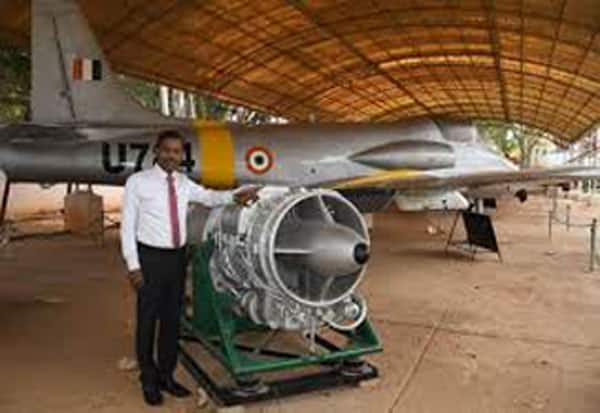/
செய்திகள்
/
Kalvimalar
/
Articles
/
Defence Scientist Dilli Babu: "A degree is not essential to work in aviation"
/
Defence Scientist Dilli Babu: "A degree is not essential to work in aviation"
Defence Scientist Dilli Babu: "A degree is not essential to work in aviation"
Defence Scientist Dilli Babu: "A degree is not essential to work in aviation"
மே 15, 2025 12:00 AM
மே 15, 2025 12:00 AM

Why is National Technology Day important?
For a nation's growth to be sustainable, it must rest on the foundation of science and technology. Many pivotal changes in our country's development—like the Green Revolution and White Revolution—stem from technological advancements. For instance, turning buffalo milk into milk powder helped India become self-sufficient in milk. Sharing such success stories with students can inspire them to achieve similar feats in the future.
How has India progressed in the aviation sector?
The Wright brothers' airplane wasn't meant for passengers; it was initially a military asset for the U.S. Army. Height offers a strategic advantage during wars, which increased the demand for aerial technologies. India joined this journey with the design of the HT-2 aircraft in 1951, followed by the HF-24 'Marut' fighter aircraft in 1961. Later, in 2001, we made history by developing the Tejas, a fourth-generation fighter jet. We are also advancing in civil aviation with aircraft like Hansa and Saras.
What role does Bengaluru play in this industry?
Bengaluru is considered India's aviation hub. Landmark projects like HT-2, HF-24, LCA Tejas, and Saras were developed here by institutions such as ADA, HAL, NAL, and DRDO labs. The Indian Institute of Science also offers specialized courses in aeronautical engineering. From design to testing, most key infrastructure is located in Bengaluru.
What's special about a fighter pilot's seat?
A fighter pilot's seat is mounted on explosive devices called pyro cartridges. In emergencies, explosives shatter the canopy and propel the seat out of the aircraft. A small parachute opens first, followed by a larger one. The seat also contains a survival kit with essentials like food. Ironically, while most people "save their seat," a fighter pilot's seat saves him!
What are other uses of parachutes?
Parachutes are crucial beyond pilot safety. They're used by special forces (paratroopers) during covert operations and to airdrop supplies and equipment. Fighter jets use tail-mounted parachutes to land quickly on short runways by reducing speed.
What should one study to enter the aviation field?
There are three core academic paths:
Aeronautics - Focuses on aircraft within Earth's atmosphere.
Astronautics - Focuses on space systems like satellites and space stations.
Aerospace - A combination of both.
Students can pursue degrees in these fields to enter aviation.
Can people from other engineering backgrounds work in aviation?
Yes. Besides aeronautical engineers, graduates in mechanical, electronics, metallurgy, computer science, mathematics, and physics can also enter this field. Even doctors can specialize in aerospace medicine. There are also various roles in civil aviation—maintenance, spare parts manufacturing, air traffic control, and cabin crew—for which training institutes exist.
Is a degree mandatory?
Not necessarily. Diploma and ITI graduates can work in manufacturing, testing, and aircraft maintenance. Certificate courses in aircraft maintenance are also available.
How does one become a commercial pilot?
Students must have studied physics and math in Class 12. They must pass exams conducted by the Directorate General of Civil Aviation (DGCA), covering five subjects. After clearing these, students earn a Student Pilot License and must complete 200 hours of flight training, including 100 hours of solo flying.
Upon passing the final exams, they receive a Commercial Pilot License (CPL). They must also qualify in radio telephony and get a type rating for specific aircraft. Training costs around ₹55-60 lakh, but loans are available.
What job opportunities exist in aviation?
Opportunities abound in research, design, manufacturing, and maintenance across organizations like DRDO, HAL, NAL, and private firms. Entrepreneurship is also encouraged through initiatives like the Defence Industrial Base, launched in Tamil Nadu and Uttar Pradesh. Aerospace parks and labs are being set up in Chennai, Coimbatore, Hosur, Trichy, and Salem with ₹4,700 crore in investment, generating numerous jobs.
What is the role of helicopters?
Helicopters don't need runways—they can take off and land vertically, hover mid-air, and fly close to the ground. This makes them vital for VIP transport, emergency rescues, medical evacuations, and firefighting. India is making strides in helicopter production, manufacturing models like ALH (Advanced Light Helicopter), LCH (Light Combat Helicopter), and LUH (Light Utility Helicopter).
Students interested in aviation can also explore this rapidly expanding segment.


